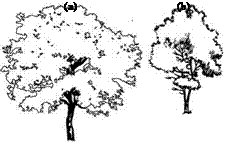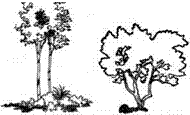There is a large number of different illustration styles for plants. At the beginning of Chap. 9 some examples were shown that only let us anticipate in how many different styles a tree can be drawn. A comprehensive demonstration of all the methods is not possible within the context of this book. However, different approaches are illustrated in the following by means of several hundred plant drawings made by different authors. The illustrations mainly originate from Evans [58]. He offers a collection of models prefabricated specially for architecture. Additional tree illustrations can be found in the literature; see, for example, [123, 198].
A first classification of the illustrations is oriented on the use of light. While
![]()
 |
 |
|
many illustrations from botany and landscaping only replicate the shape of the plant, architectural illustrations also use light and shadows. The motivation for the often exclusive usage of the general form results from the descriptive character of botanical drawings, which mostly aim at illustrating the spatial divisions in a plant community. Architects and designers, however, are interested in the light exchange between the objects of a planned ensemble, and create their illustrations accordingly.
Thus, for the algorithmic production of plant illustrations three factors have to be examined. Firstly, the representation of the general plant shape that must be generated in any case; secondly, the light effects and their representation; and, thirdly, the drawing-like production of a tree skeleton.
![]() The form of a tree is in most of the illustrations generated using two methods: either the artists use figural abstraction, or the presentation of form takes place through visual agglomeration of many small objects that constitute the model. With figural abstraction, the tree is illustrated using a few strokes. Examples are shown in Fig. 11.4. While in the subfigures (a) and (d) the mere outline was drawn, in (b) and (c) cross-hatchings indicate additionally the threedimensional shapes of the trees.
The form of a tree is in most of the illustrations generated using two methods: either the artists use figural abstraction, or the presentation of form takes place through visual agglomeration of many small objects that constitute the model. With figural abstraction, the tree is illustrated using a few strokes. Examples are shown in Fig. 11.4. While in the subfigures (a) and (d) the mere outline was drawn, in (b) and (c) cross-hatchings indicate additionally the threedimensional shapes of the trees.
With visual agglomeration, the form of the tree, and especially the shape of the foliage, is generated using a collection of many small objects. Examples are shown in Fig. 11.5: while for (a) relatively abstract primitives were used, the chestnut in (b) consists of more-exact visual approximations of the chestnut leaves. In the tree in (c), the leaves are indicated just by point-shaped objects.
Thus, in an algorithmic implementation the leaves should possibly be generated using primitive objects, whose appearances can vary from extremely abstract forms to realistic outlines. That also means that the presentation of the leaves must occur in a relatively general manner, and may no longer be limited to the geometry of the real leaf shape. Therefore, it is necessary to specially process the data provided by the plant-generating programs, and to store the leaves in the form of abstract primitives.
Let us turn to the rendering of light and shadows. In most of the artworks the illustrators use two methods for the trees: either the wealth of details of an illustration is varied in order to represent lighter and darker areas or crosshatchings are used. The upper part of Fig. 11.6 shows a number of trees that
|
|
|

were created by varying the detail richness. Depending on the drawing style, the densities of the primitive objects were varied and also their appearances. As an example, the dark areas of the crown were blackened additionally using thicker contours of the primitives.
![]() The applications of cross-hatching are manifold. Depending on the drawing style, one or more directed cross-hatchings are overlaid, some of the artworks display relatively long cross hatching lines. The lower part of Fig. 11.6 shows some examples that reflect the variations available using these techniques. When viewing the shadow areas of tree sketches we notice a commonality: the intensity distribution can be divided into two or three areas. One area consists of the part of the crown that is fully affected by the light. This area is mostly represented only with a few strokes. Another area lies in the penumbra; here a medium lighting has to be achieved; the necessary strokes are generated using cross-hatching. The last area encompasses the dark shadow. In the illustrations, which modify the grey values of the illustration through variations of details, this is obtained using additional detail or through thicker lines that are extended to the black areas (see also Fig. 11.6 left bottom).
The applications of cross-hatching are manifold. Depending on the drawing style, one or more directed cross-hatchings are overlaid, some of the artworks display relatively long cross hatching lines. The lower part of Fig. 11.6 shows some examples that reflect the variations available using these techniques. When viewing the shadow areas of tree sketches we notice a commonality: the intensity distribution can be divided into two or three areas. One area consists of the part of the crown that is fully affected by the light. This area is mostly represented only with a few strokes. Another area lies in the penumbra; here a medium lighting has to be achieved; the necessary strokes are generated using cross-hatching. The last area encompasses the dark shadow. In the illustrations, which modify the grey values of the illustration through variations of details, this is obtained using additional detail or through thicker lines that are extended to the black areas (see also Fig. 11.6 left bottom).
All three areas do not exist in each drawing. However, the above division offers a chance to achieve from the algorithmic viewpoint complete definitions of the problems. If an algorithm for the automatic rendering of plant sketches is able to render all areas with their integral elements, and at the same time to separate these areas, a potential solution of the problem is ascertained. Of course, this does not mean that there are no other rendering methods (see Fig. 11.5c). However, a great number of the drawing styles could be covered through such a solution.
From the illustrations shown so far it becomes evident that the imitation of a natural leaf or branch form is in no way the only means to achieve the characteristic appearance of a tree. In fact, there exist very different approaches for the computer-assisted illustration of foliage and tree skeletons.
![]() Figure 11.7 shows the range of options. On the one hand there are drawing styles in which the foliage is a combination of many primitives, similar to those
Figure 11.7 shows the range of options. On the one hand there are drawing styles in which the foliage is a combination of many primitives, similar to those
|
|
|


|
|
|

that were already introduced. The rendering of the primitives varies from realistic three-dimensional renderings to flatter two-dimensional-looking objects up to abstract points.
On the other hand, we can replicate the characteristics of a tree using abstract lines. Such drawing styles are also seen in Fig. 11.7. Part (b) shows a tree (probably an oak) whose foliage was given depth using added elements such as indications of cross-hatchings. In part (c) this is not expressed that strongly, i. e., the foliage is almost exclusively represented using lines. In both cases the lines function as silhouettes and thereby represent the tree as an entity.
 |
 |
tree skeleton ^ Just like the rendering methods for foliage, different drawing styles are available for rendering the tree skeleton. These range from realistic representations of the tree skeleton up to mere silhouettes (see Fig. 11.8). Here shorter and longer cross-hatching lines are used; the lines can be overlaid in several crosshatching directions.
A special case, interesting from the algorithmic viewpoint comes into effect when in specific styles the directions of cross-hatching lines are selected in such a way that they can also be interpreted as intersection lines between the object and a number of planes. Such examples are also to be seen in Fig. 11.8. Further down we introduce an algorithmic implementation of these processes, and show synthetically generated images. Beforehand, however, we will discuss a computer-based method with which the foliage of a tree can be “drawn” with a high degree of freedom in the style of the already-presented hand-drawn images.



